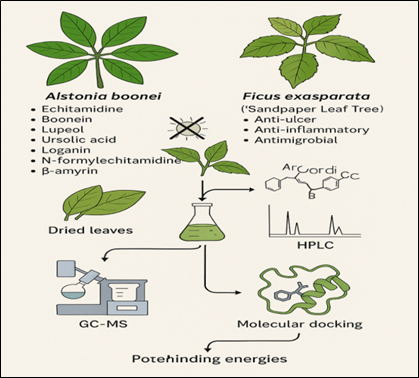Molecular interactions of Gas Chromatography – Mass Spectrometry (GC-MS) and HPLC Characterization of Alstonia Boonei and Ficus Exasperata Leaves Methanol Extracts
DOI:
https://doi.org/10.26438/ijsrbs.v12i3.692Keywords:
Gas chromatography, molecular interaction, Ficus, Astonia, methanolAbstract
Alstonia boonei is a well-known plant whose components are high in bioactive chemicals such echitamidine, boonein, lupeol, ursolic acid, loganin, N- formylechitamidine and b-amyrin, with triterpenoids and alkaloids accounting for a large fraction of the total bioactive compound while Ficus exasperata Vahl. (F. exasperata) sometimes known as "Sandpaper Leaf Tree" because of the coarse surface of its leaves, is utilized for the management of various diseases, and as a result, research supporting traditional uses are expanding According to reports, F. exasperata leaves have anti-ulcer, oxytocin inhibiting, anticonvulsant, antinociceptive, antipyretic, anti-inflammatory, antimicrobial, anxiolytic, hypolipidemic, anti-candidal, insecticidal, hypoglycemic, and pesticidal propertie. The leave of Ficus exasperata' and Alstonia boonei were dried in a laboratory environment devoid of direct sunlight till completely dry, after which they were extratec using methanol and then rotaroy evaporated to collect the extracts. Both the GC-MS and HPLC analyses revealed the presence of some biochemically useful hydrocarbons while the molecular docking results revealed the potential usefulness of some of these compounds as medicinal compounds as a result of the binding energies.
References
R. Singh, S.K. Singh, S. Arora, “Evaluation of antioxidant potential of ethyl acetate extract/fractions of Acacia auriculiformis,” A. Cunn. Food and Chemical Toxicology, Vol.45, pp.1216-1223, 2007.
E.F. Bafor, E.K. Omogbai, R.I. Ozolua, “Oxytocin inhibiting effect of the aqueous leaf extract of Ficus exasperata (Moraceae) on the isolated rat uterus,” Acta Poloniae Pharmaceutica, Vol.68, pp.541-547, 2011.
P.A. Akah, O.E. Orisakwe, K.S. Gamaniel, A. Shittu, “Evaluation of Nigerian traditional medicines: II. Effects of some Nigerian folk remedies on peptic ulcer,” Journal of Ethnopharmacology, Vol.62, pp.123-127, 1998.
S.O. Adewole, T. Adenowo, T. Naicker, J.A. Ojewole, “Hypoglycaemic and hypotensive effects of Ficus exasperata Vahl. (Moraceae) leaf aqueous extract in rats,” African Journal of Traditional, Complementary and Alternative Medicine, Vol.8, pp.275-283, 2011.
E. Woode, R.A. Poku, G.K. Ainooson, E. Boakye-Gyasi, W.K. Abotsi, T.L. Mensah, A.K. Amoh-Barimah, “An evaluation of the anti-inflammatory, antipyretic and antinociceptive effects of Ficus exasperata (Vahl) leaf extract,” Journal of Pharmacology and Toxicology Vol.4 Issue4, pp.138-151, 2009.
A.C. Akinmoladun, E.O. Ibukun, E. Afor, B.L. Akinrinlola, T.R. Onibon, A. Akinboboye, E.M. Obuotor, E.O. Farombi, “Chemical constituents and antioxidant activity of Alstonia boonei,” African Journal of Biotechnology, Vol.6, Issue 10, pp.1197-1201, 2007.
A.L. Harvey, “Natural products in drug discovery,” Drug Discov. Today, Vol.13, Issue 19-20, pp.894-901, 2008.
Jamshidi-Kia F, Lorigooini Z, Amini-Khoei H. Medicinal plants: past history and future perspective. J Herbmed Pharmacol., Vol.7, Issue.1, pp.1-7, 2018. doi: 10.15171/jhp. 2018.01
C. Bârsu, “History of medicine and its roles,” Clujul Medical, Vol.80, Issue 3, pp.727–729, 2007.
C. Orwa, A. Mutua, R. Kindt, R. Jamnadass, A. Simons, “Agroforestree database: A tree reference and selection guide,” version 4.0, 2009. Available: http://www.worldagroforestry.org/af/treedb/.
D.C. Taylor-Robinson, N. Maayan, K. Soares-Weiser, S. Donegan, P. Garner, “Deworming drugs for soil-transmitted intestinal worms in children: effects on nutritional indicators, haemoglobin and school performance,” Cochrane Database Syst Rev., Vol.11, Issue 7, pp.CD000371, 2012.
E.E. Bafor, O. Igbinuwen, “Acute toxicity studies of the leaf extract of Ficus exasperata on haematological parameters, body weight and body temperature,” J. Ethnopharmacol, Vol.123, Issue 2, pp.302-307, 2009.
S.C. Chhabra, R.L. Mahunnah, E.N. Mshiu, “Plants used in traditional medicine in eastern Tanzania. IV. Angiosperms (Mimosaceae to Papilionaceae),” J. Ethnopharmacol, Vol.29, pp.295-323, 1990.
O. Trott, A.J. Olson, “AutoDock Vina: improving the speed and accuracy of docking with a new scoring function, efficient optimization, and multithreading,” J. Comput. Chem. Vol.31, Issue 2, pp.455-461, 2010.
T. Pantsar, A. Poso, “Binding Affinity via Docking: Fact and Fiction,” Molecules, Vol.23, Issue 8, pp.1899, 2018.
D. Yusuf, A.M. Davis, G.J. Kleywegt, S. Schmitt, “An Alternative method for the evaluation of docking performance: RSR vs RMSD,” Journal of Chemical Information and Modeling, Vol.48, pp.1411–1422, 2008.
G. Kenneth, G. Oliver, S. Conron, R. Munir, K. Vandewal, J. Chen, S. Sweetnam, M. Thompson, A. Salleo, M. Mcgehee, A. Amassian, “Organic Electronics: The Roles of Structural Order and Intermolecular Interactions in Determining Ionization Energies and Charge-Transfer State Energies in Organic Semiconductors,” Adv. Energy Mater. Vol.6, 10.1002/aenm.201670127. 2016.
A. Melissa, H. Babilonia-Rosa, K. K. Maria, T. Oliver-Hoyo, ”Using 3D printed physical models to monitor knowledge integration in biochemistry,” Chemistry Education Research and Practice, Vol.19, Issue 4, pp.1199-1215, 2018.

Downloads
Published
How to Cite
Issue
Section
License

This work is licensed under a Creative Commons Attribution 4.0 International License.
Authors contributing to this journal agree to publish their articles under the Creative Commons Attribution 4.0 International License, allowing third parties to share their work (copy, distribute, transmit) and to adapt it, under the condition that the authors are given credit and that in the event of reuse or distribution, the terms of this license are made clear.






